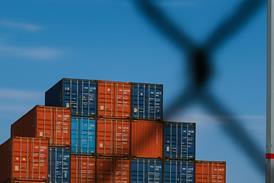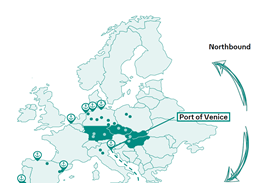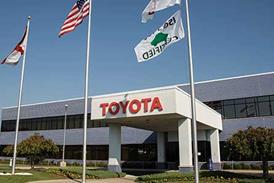Cost pressures across automotive logistics are escalating as OEMs prioritise profitability to finance EV transitions and counter rising competition.

Cost cutting has become the automotive industry’s priority in 2024, as OEMs desperately try to retain operating margins in a difficult market where EV supply and consumer demand remains unbalanced.
While cost pressures have always been present within automotive logistics – fundamentally because it is a highly fragmented and therefore highly competitive and low margin business – it has become crucial this year, as carmakers urgently need profitability to finance the huge capital expenditure required for the EV transition.
However, we need to go back a few years to better understand how the market dynamics have fundamentally changed.
The effect of freight rates and shipping firm acquisitions on logistics revenue
As the automotive logistics industry emerged from the highly disruptive Covid period, freight rates across road and air, and in particular for shipping, were elevated with container shipping rates peaking at $10,000 per container – around five times the industry average of ~$2,000 per container. For some shipping companies such as Maersk, CMA-CGM, and MSC, this bonanza allowed them to go on acquisition sprees, widening their portfolio of logistics services.
Read more: A highly competitive logistics landscape is squeezing margins and stifling investment
Freight rates fell back to historical norms in 2023, and aside from a brief spike in mid-2024 due to the Suez crisis, freight rates across road, air and shipping have normalised, ultimately meaning less revenue for logistics operators.
Auto industry shift from production constrained to demand constrained
For automotive OEMs, the 2020-2022 period was a heavily production-constrained period due to component shortages, which resulted in OEMs focusing on value over volume and prioritising higher margin SUVs and pick-ups.
North American Automotive Logistics Market Report 2024-2033
Even though they were producing lower overall volumes, this value-focus allowed OEMs to avoid discounting, instead charging ticket price or above for some vehicles and resulting overall in a strong period of profitability for OEMs, despite the high logistics costs that freight rates were imposing upon them. Due to this high profitability, in many instances, OEMs were willing to pay almost whatever it took for air freight and priority freight to make sure that critical components including semiconductors and wire harnesses got to vehicle assembly lines to allow production plants to keep operating.

However, from 2022-2023, as supply chain disruptions gradually eased and volumes recovered, the inflationary effects of higher labour, fuel, energy and logistics costs began to increase cost pressure. Topline demand also didn’t quite bounce back to the pre-Covid volumes that were expected, and the industry reverted to the more traditional demand-constrained market dynamic. Furthermore, Tesla helped trigger a price war which meant many OEMs either had to accept declining market share or lower their prices to remain competitive, in some cases even selling EVs at a loss. For example, Ford was reportedly losing $50,000 on each EV sold, with a total loss of Ford E division in H1/2024 reaching $2.5 billion.
Margin compression
This has resulted in a classic margin compression which we are now seeing play out across the wider automotive industry.
New vevhicles are becoming prohibitively expensive, and consumers are baulking at the price of new vehicles, particularly EVs, as they start to see much cheaper alternatives emerge from China.
Not only that, but OEMs are facing costs headwinds in almost every direction, with the slowdown in EV sales, protectionist tariffs, and the complexities of the US Inflation Reduction Act (IRA) proving costly, as reported on Automotive Logistics’ sister site AMS.
Therefore in 2024, cost cutting has become the automotive industry’s priority, as OEMs desperately try and retain operating margins – not only to remain profitable - but they urgently need that profitability to finance the huge capital expenditure required for the EV transition. Volkswagen Group’s chief financial officer (CFO) has conceded as much, stating: “We have been spending more money at the brand than we earn for some time now. That doesn’t go well in the long term. If we carry on like this, we won’t succeed in the transformation.”
OEM cost cutting
Legacy automakers, particular VW, Ford and Stellantis, are struggling financially and failing to produce EVs at competitive prices to Tesla, and this is compounded by the emerging impact of cheaper Chinese EVs from brands like BYD, SAIC and NIO.
For example, the severity of the situation is leading to dramatic moves by OEMs with VW proposing the closure of 3 production plants, significant jobs losses, plus a 10% reduction in pay.
The seriousness of the predicament VW is in has been underscored by Volkswagen Group CEO Oliver Blume, who said there was no flexibility on cost-cutting goals.
Likewise, Stellantis reported that its profits for the first half of 2024 halved leading to a focus upon cost reduction and the company stated that they are also taking greater control of their FVL operations to get a better grip upon costs.
And of course, EV prices are one of the critical areas to reduce costs. For example, Ford will realign its US battery sourcing plan to reduce costs, maximise capacity utilisation, and support current and future EV production. Ford president and CEO Jim Farley also noted: “If you are not competitive on battery cost, you are not competitive.”
Knock-on effects for automotive logistics
Automotive logistics constitutes ~8% of a vehicle’s retail price, according to Automotive Logistics’ market reports. Therefore, OEMs will be looking at every part of the value chain to eke out any possible efficiencies and savings they can find, which will undoubtedly include both inbound and outbound finished vehicle logistics. The inevitable impact will be that OEMs will exert increasing pressure on LSPs to reduce costs.
Clearly the best and most appropriate cost saving strategies will depend upon where any particular LSP is positioned within the logistics ecosystem, their scale, regional focus, strengths and weaknesses. But nonetheless, the reality remains that cost pressures will increase for logistics providers, and they will invariably need to make those costs savings to remain competitive in a highly fragmented logistics landscape.
Example automotive logistics cost saving strategies:
| Strategy | Example | Goal of implementing strategy |
|---|---|---|
| Control towers | Volkswagen Group of America creates its Virtual Task Force | Unite VW’s US, Mexico and Canada divisions under one umbrella |
| Digitalisation and automation | Stellantis’ use of AI projects for digital twins and retrofitting equipment with partners | Improve productivity across plants and operations with a strong automation focus and digitalisation of in-plant logistics |
| Localisation | BMW’s drive toward a regionalised battery supply chain in North America | Increase competitiveness by having control over tehnological expertise and raw materials |
| Intermodal benefits | BNSF, GMXT and JB Hunt team up for intermodal cross-border service | Cut delivery times on existing services, offer alternative cross-border routes and improve resiliency |
| Better inventory management | Reducing costs by migrating from a Build To Stock (BTS) to a Build To Order (BTO) model | Cut inventory carrying costs, reduce stock imbalances, limit the need for expedited shipments and level out inbound route variability |
| Supply chain design | Stellantis’ aim to ensure access to critical logistics capacity | Gain the ability to influence the supply chain and manufacturing end-to-end, increasing resiliency and competitiveness |
| Industry consolidation | DSV wins €14.3 billion acquisition of DB Schenker in a move to elevate global logistics reach and capabilities | Improve logistics to enhance cost competitiveness and ultimately reduce total cost of vehicles |
Digitalisation and sustainability
While experiencing this cost pressure, both inbound and FVL providers are also being compelled to modernise and digitalise their services to achieve better visibility and simultaneously investing in new low-carbon or zero carbon fleets to achieve a net zero future, both of which ultimately drive logistics operating costs higher and squeeze operating margins even further. The only real viable solution to squaring this circle is for OEMs, LSPs and the wider logistics industry to partner, cooperate and collaborate to pool resources and share the investment and risks to achieve those wider industry objectives and keep costs down.
For further insight into the automotive logistics market, please see the latest editions of our series of business intelligence reports:
North American Automotive Logistics Market Report 2025-2035
European Automotive Logistics Market Report 2024-2034
Save 20% when download the two business intelligence reports!
Topics
- AI & Predictive Analytics
- Analysis
- Battery Supply Chain
- Cross-Border Logistics
- Data
- Digitalisation
- DSV
- Editor's pick
- Electric Vehicles
- Finished Vehicle Logistics
- Ford
- Inbound Logistics
- Inventory management
- Logistics service provider
- Maersk
- Nearshoring
- News
- Ports and processors
- Purchasing
- Rail
- Road
- Shipping
- Stellantis
- Suppliers
- Supply Chain Planning
- Sustainability
- Tesla
- Trade & Customs
- Volkswagen








































1 Reader's comment